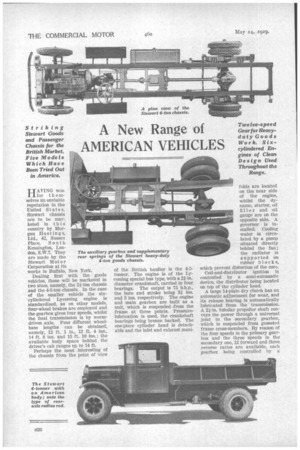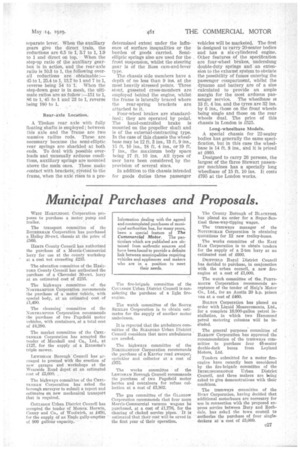A New Range of AMERICAN VEHICLES
Page 56

Page 57

If you've noticed an error in this article please click here to report it so we can fix it.
HAVING won for themselves an enviable reputation in the United State s, Stewart chassis
are to be mar. i keted n this country by Morgan Hastings, Ltd., 42, Sussex Place, South Kensington, London, S.W.7. They are made by the Stewart Motor Corporation at its works in Buffalo, New York.
Dealing first with the goods vehicles, these will be marketed in two sizes, namely, the 21-ton chassis and the 4-5-ton chassis. In the case of the smaller vehicle the sixcylindered Lycoming engine is Standardized, as on other models, four-wheel brakes are employed and the gearbox gives four speeds, whilst the final transmission is by wormdriven axle. Four different wheelbase lengths can be obtained, namely, 12 ft. 1 in., 13 ft. 4 ins., 14 ft. 8 ins. and 15 ft. 10 ins.; the available body space behind the driver's cab ranges up to 14 ft.
Perhaps the most interesting of the chassis from the point of view
of the British haulier is the 4-5tonner. The engine is of the Lycoming special bus type, with a 21-in. diameter crank'shaft, carried in four bearings. The output is 75 b.h.p., the bore and stroke being 31 ins. and 5 ins. respectively. The engine and main gearbox are built as a unit, which is suspended ,from the frame at three points. Pressurelubrication is used, the crankshaft bearings being bronze backed. The one-piece cylinder head is detachable and the inlet and exhaust mani
folds are located on the near side of the engine, whilst the dynamo, starter, oil filler and oil. gauge are on the opposite side. A governor is installed. Cooling water is circulated by a pump situated directly behind the fan; the radiator is supported on rubber block s, which prevent distortion of the core.
Coil-and-distributor ignition is controlled by a semi-automatic device, the distributor being located on top of the cylinder head.
A large 14-plate dry clutch has an automatic adjustment for wear, and its release bearing is automatically lubricated from the transmission. A 21-in, tubular propeller shaft conveys the power through a universal joint to the secondary gearbox, which is suspended from gusseted frame cross-members. By reason of the four speeds in the primary gearbox and the three speeds in the secondary one, 12 forward and three reverse ratios are available, each gearbox being controlled by a separate lever: When the auxiliary gears give the direct train, the reductions are 6.5 to 1, 3.7 to 1, 1.9 to 1 and direct on top. When the step-up ratio of the auxiliary"gearbox is in action, and the rear-axle ratio is 10.3 to 1, the folloWing overall reductions are obtainable :45 to 1, 25.4 to 1, 137 to 1 and 7 to 1, reverse being 54 to 1. When the step-down gear is in -inesh, the ultimate ratios are aS folloW :-151 to 1, 86 to 1,'45 to 1 and 23 to 1, reverse being 180 to 1.
Rear-axle Locution,
A. Timken rear axle with fully floating shafts is employed ; between this axle and the .frame are two massive radius rods. These. are necessary because the semi-elliptic rear springs are shaCkled at both ends. To deal with possible overloads and unusually arduous conditions, auxiliary springs are mounted above the main ones. These. Make contact with brackets; riveted to the frame, when the axle rises to a pre
determined extent under the influence of surface inequalities or the burden of goods carried. Semielliptic springs also are used for the front suspesion,I whilst the steering gear is of the Ross cam-and-lever type.
The chassis side members have a depth of no less than 0 ins, at the most heavily stressed points. Three stout, gusseted cross-members are employed behind the engine, whilst the frame is laterally braced where the rear-spring brackets are attached to it.
Four-wheel brakes are standardized; they are operated by pedal. The hand-controlled brake is mounted on the propeller shaft and is of the external-contracting type. In the case of this chassis the wheelbase may be 12 ft. 3 ins.; 13 ft. 9 ins., 15 ft. 10 ins., 18 ft. 4 ins., or 19 ft. 7 ins., the maximum body space being 17 ft. 10 ins. All types of user have been considered, by the provision of several sizes.
In addition to the chassis intended for goods duties three passenger
vehicles will be marketed. The first is designed to carry 20-seater bodies and has a six-cylindered engine. Other features of the specification are four-wheel brakes, underslung double-duty springs and an extension to the exhaust system to obviate the possibility of fumes I entering the passenger compartment, whilst the dynamo and battery are of a size calculated to provide an ample margin for the most arduous passenger service. The wheelbase is 13 ft. 4 ins, and the tyres are 32 ins. by 6 ins., those on the front wheels being single and those on the rear wheels dual, The price of this chassis in London is £525.
Lout-wheelbase Models.
A special chassis for 22-seater bodies has generally the same specification, but in this case the wheelbase is 14 ft. 8 ins., and it is priced at £660.
Designed to carry 26 persons, the largest of the three Stewart passenger machines has a specially long wheelbase of 15 ft. 10 ins. It costs £795 at the London works.




























































































































